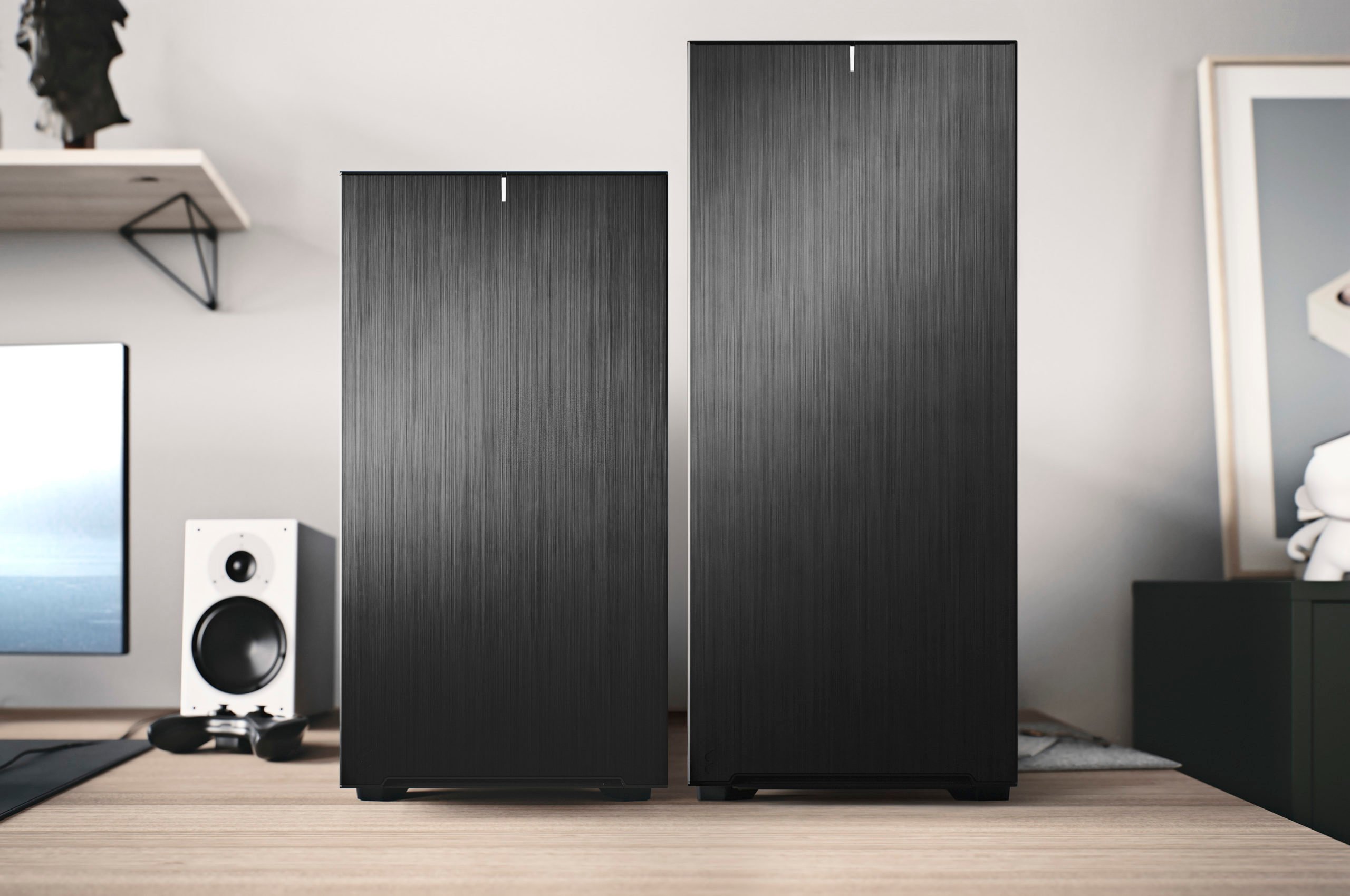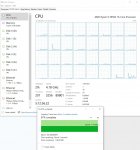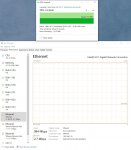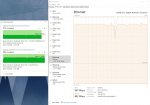Stereodude
Not really a
I repeated the same case closed P95 Small FFT hour+ test today with PBO off with just the stock clocks/voltages. It settled at 64.5C and was running ~3875MHz and ~100W. So ~3% performance costs ~33% in power and ~15C.
My guess is that by putting in really large numbers some divider settings are changed which reduces how granular the adjustment can be. It's also possible that such large values break the tuning algorithm. Or maybe it is just buggy.I with you on how much more power is needed for such a small boost. I was finding it fascinating how it is working (or lack there of).
That's the speed reported by Ryzen Master, not another utility right? I saw numbers slightly above and below what I posted on the graph in Ryzen Master for the cores. Like 3866 and 3883... I just sort of averaged them in my head and reported that.Maybe I hit some bad silicon lottery and/or I'm missing a setting somewhere. If I run the same small FFT test with PBO off (Default mode), Coupled mode on, and everything else stock, mine also settles around 64C at roughly 92W and 95A but with a speed of around 3,630MHz.

Which 140mm Noctua fans are you using? I was thinking to perhaps swap out the stock Fractal Design 140mm fans for either the Noctua NF-A14 PWM or the BeQuiet Silent Wings 3 PWM high-speed. Either can move more air than the included Fractal Design X2 140mm fan though not by much per the specs. I'm skeptical of the airflow specs given the RPM difference.I also have 3 x 140mm Noctua for the case and the motherboard temp never moved from 38C.
Maybe I will get some and try it to see how it compares to the stuff Scythe included. What size did you get? I saw some people on Amazon complaining they got what they presume to be fake stuff (due to the bad performance).They were running somewhere around 800-900RPM for the same workload on the CPU. The case fans were about the same since they're set to monitor the MB temp, not the CPU temp.
I'm not sure what features the 1600AF has. The 3950X will actually go even lower. It will straight up put cores to sleep and just show "sleep" for most of them.I find it interesting that in Stereodude's latest screenshot, it appears to be idling at ~300MHz all-core. That's actually way lower than the lowest idle I've seen from a modern chip (the N3050's 480MHz is what I'm comparing against) and I find that interesting -- is that kind of power-savings only available at the crazy high end, or can I expect something similar out of my 1600AF once it arrives? I know I don't get access to Ryzen Master -- I can't remember if that's restricted to the 3000 series in general or just their non-budget line, but I'm very interested to see what I can get out of mine.
I checked and the NH-D15 does come with NT-H1. I should have just tried that first.@Handruin I think the NH-D15 came with NT-H1, but I don't remember if my NH-D15S came with it (edit shortly before posting: it did, I don't know why I didn't use it). I seem to vaguely remember that I've got Arctic Silver 5 between my IHS and heatsink. I'll probably dig my box out and see if I've still got mine and that's likely what I'll use on my 1600AF.
The sleep state will happen when you have a CPU with numerous cores like these. Not all tasks/processes will make use of multithreading and the OS is getting smarter to stick/pin threads to specific cores and let others sleep. During the times when you're using your system without maxing out the CPU, putting certain cores to sleep should happen. This isn't specific to you shutting down the system to save power, it's meant as an efficiency thing during normal usage.Well, considering it's just a 2600 hiding behind the old 1600 name (the AF moniker is an unofficial one to differentiate it from the original 1600 whose P/N ends in AE) I'd probably say anything it can do, the 1600AF can do as well. I'm not sure what that means, and likely won't until I get it in the post and test for myself, but I was mostly asking rhetorically there. It'd be nice to see it put most of my hardware to sleep, but I'd never see it anyway -- idle for me is around 10-20% CPU usage here on my 3570K since I use this as a bit of a home server as well.
I'm not sure what I'm doing with this once I've got the Ryzen hardware built in here -- I have a few ideas, ranging from just selling it to recoup some costs to building a server out of it. I might even give it to my dad, he's still running my old Phenom II x4 945 machine. But I digress.
Like I said, it'd be cool to see it put cores to sleep, but if I ever get a server running and don't need this machine up 24/7 anymore, it likely won't ever be just going to sleep -- I'll be turning it off.
To add to that it's supposed to stick them to the cores that can run the fastest out of all the cores in the CPU.Not all tasks/processes will make use of multithreading and the OS is getting smarter to stick/pin threads to specific cores and let others sleep.
Are you sure about that? AMD's documentation says it will install and run under Windows 10 on any AMD Ryzen processor. The Ryzen processors before the 3000 series have a lot less supported features, but it is supposed to run.I know I don't get access to Ryzen Master -- I can't remember if that's restricted to the 3000 series in general or just their non-budget line, but I'm very interested to see what I can get out of mine.
Where do you keep getting these understandings from? The 3950X isn't an enterprise CPU. Generally these sorts of features are inherent to the architecture and would extend across all models.It'd be cool to see it power down all but maybe 2 cores when I'm "idling" but I understand if that sort of thing is restricted to not only the 3000 series, but the Enterprise end of it.
So would this be something I might see on Linux, perhaps when using a different CPU scheduler? I currently use MuQSS on my ck-patched copy of 5.5.2. It'd be cool to see it power down all but maybe 2 cores when I'm "idling" but I understand if that sort of thing is restricted to not only the 3000 series, but the Enterprise end of it. Plus, it's a desktop machine anyway, power savings is nice but not a priority -- I imagine I'd save more power by being able to turn my DisplayPort monitors off without losing window placement (one day I'll make those cables that shunt the HPD pin to a resistor or whatever that was) or being able to let them sleep.

 www.fractal-design.com
www.fractal-design.com
I coupled the exhaust case fan in the back to the VRM temp. The front two fans are tied to other temperature sensors on the motherboard. The front two fans are still the included FD fans.My NF-A14 rarely spin up much past 800-900RPM. I tied their speed to the motherboard temps versus the CPU. Did you couple yours to the CPU temps? They can get noisy at 100% but I don't see myself ever needing that. I think the included FD fans max out at 1000RPM so the Noctua fans can go a bit faster.
I am disappointed that fractal included three fans without PWM given the cost of the case. This isn't a budget case by any means.
Where do you keep getting these understandings from? The 3950X isn't an enterprise CPU. Generally these sorts of features are inherent to the architecture and would extend across all models.






I'm skeptical of that because the iperf results were 900+mbps each way. I'm pretty sure the last time the Mikrotik units were causing me trouble (before the firmware update) the problem showed in iperf as well, not just SMB. I will have to see how it does transfering to and from another 1gig system instead of 10gig systems.Maybe some weird anomaly with the Mikrotik and the Intel i211?
Everything is at the default. I'll have to look a little closer into the details. I was basically out all day and only just got home a little while ago and won't get any time on this until tomorrow.Any chance the MTU is not matching between the switch and your desktop for the 1Gb ports? I could see that causing some performance oddities if you change it to MTU 9000 for the 10Gb cards and it set globally.
It looks like you may have been correct after all. 1gig to 1gig does this whether pushing or pulling.Maybe some weird anomaly with the Mikrotik and the Intel i211?

We bought our cases too soon.

Introducing Define 7 and Define 7 XL
Fractal Design today launched the latest models in the esteemed Define series: 7 and 7 XL.www.fractal-design.com
